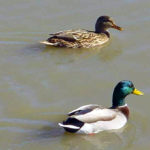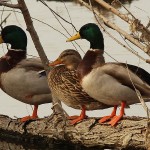This interesting odd couple are very dedicated to each other. This is a male wild Mallard and his friend, the distantly related domestic duck, known as an American Pekin.
I have been visiting this pond for several weeks now, and these two ducks are always together. Strangely, the domestic duck also appears to be a male as indicated by his curly tail feathers (a trait the two ducks have in common). So, I’m not quite sure what is going on with these two. Strange.


Here is what Wikipedia has to say about the Mallard and their relation to many breed of domesticated ducks:
The Mallard (/ˈmælɑrd/ or /ˈmælərd/) or Wild Duck (Anas platyrhynchos) is a dabbling duck which breeds throughout the temperate and subtropical Americas, Europe, Asia, and North Africa, and has been introduced to New Zealand and Australia. This duck belongs to the subfamily Anatinae of the waterfowl family Anatidae.
The male birds (drakes) have a glossy green head and are grey on wings and belly, while the females have mainly brown-speckled plumage. Mallards live in wetlands, eat water plants and small animals, and are gregarious. This species is the ancestor of most breeds of domestic ducks.
The American Pekin Duck, Pekin duck, or Long Island duck (Anas platyrhynchos domestica, or Anas peking), is a breed of domesticated duck used primarily for egg and meat production. It was bred from the Mallard in China. The ancestors of those ducks originated from the canals which linked waterways in Nanjing and originally had small bodies and black feathers. With the relocation of the Chinese capital to Beijing, supply barge traffic increased in the area which would often spill grain on which the ducks fed. Over time, the ducks slowly increased in size and grew white feathers. By the Five Dynasties, the new breed of duck had been domesticated by Chinese farmers







Hi Chris, Do you know that the “mallard” is indeed a “wild mallard”? Pekin ducks may have mallard plumage. I have heard them called “barnyard mallards.” Pekin ducks also interbreed with mallards. In park populations of Pekin ducks a full range of plumage from stark white to being indistinguishable from a mallard occurs.
So far as the two associating, though both appear to be males, or at least to have male secondary sexual characteristics, domestic ducks are social
Well, David, I guess i should start by admitting that I did not know that the Pekin duck could resemble a wild Mallard. That being said, my assumption that the individual in this picture is a wild Mallard is based on the many other wild Mallards at this pond. There are dozens of them. In comparison to the others, I noticed nothing that would distinguish this one, except that he prefers the company of the domestic duck. His size is inline with the other Mallards at this pond, which makes this individual just a fraction of the size of the larger domestic duck. From what I understand, the size difference alone should be enough to make the differentiation, but maybe I am wrong… what do you think?
Probably is a true, wild mallard. But, not all domestic “mallards” are large. There is a breed of duck that is called a “call duck,” because they were used as decoys for wild ducks. The plumage is mallard plumage, and the duck is as small as or smaller than a wild mallard.
Hey was this by any chance in country place? I’m pretty sure it’s still a thing. I actually have been noticing them for a few weeks myself and it’s 2019… they are always together. I will send a picture!
hi there, I rescued an orphaned wild mallard and raised him with a pekin for company. They ended up being two males as well. I released them at a neighbors private pond (and feed them every day). the two above look just like mine (but they aren’t because mine were both born in the spring of 2015. My two hang out together all the time. 🙂
I just saw two mallards along with a male peking duck swimming together in the small lake behind my house. Had to Google this as I was surprised and came upon your site. They walked up to the bird feeder and ate the seed that has fallen to the ground and they were getting along real good. I’m guessing the peking duck must be able to fly. He was more lean like the one in your photo. I was hoping to see if he would fly but they all waddled back down to the lake.
Please see our paper “An intercross population study reveals genes associated with body size and plumage color in ducks”, https://www.nature.com/articles/s41467-018-04868-4
Hello from Weatherford tx, I have a bird farm, and a few duck breeds male and female, more female than male, with those are mallard male and Peking female, and they also breed together. I have eggs from them.in incubating now.
There is a pair exactly like this in Golden Gate Park in San Francisco. Always together, male mallard and male Pekin.
I know that couple – sadly it seems the male mallard has been missing since October. The white Pekin is hanging out with a goose friend now.
I just saw an American Pekin (not sure of gender) and a female Mallard together on the Cannon River in the Carleton Arboretum this morning! I took a photo, though could not get close enough for it to be any good. They were side by side, dipping underwater to forage.
Hello! I live in a subdivision in a suburb outside of Dallas. At our neighborhood pond that I walk at multiple times a week there is a Pekin and mallard that never leave each other’s side. This has been going on for months now. Not sure of genders but they seem more aware of dangers than many of the other ducks such as crossing the road by flying instead of walking and looking both ways for cars multiple times which seems to be the teachings of the Pekin. It’s quite interesting. Many of the other mallards often stand and sit in the road. I googled the combination because I found it so odd they’ve stuck together so long.